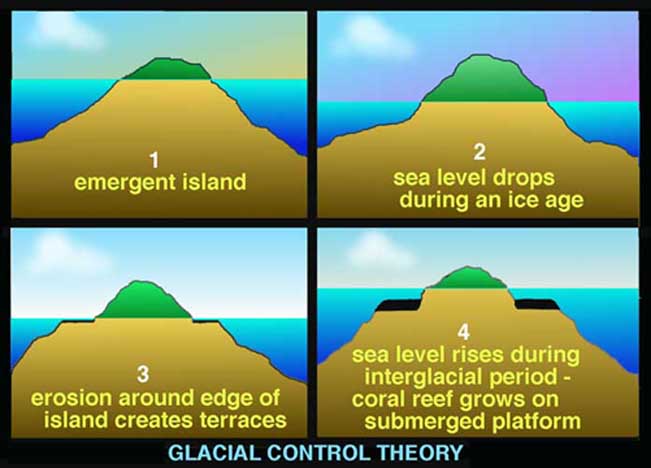GlacialActivity
Glacial Activity
In the early 20th century, an American geologist named Reginald Daly proposed that the foundations of modern coral reefs were created during the last glacial period. Because glaciers held large amounts of sea water on land, the sea level was lower during this time period. Wave patterns formed erosional terraces that corals would later colonize. [1] His ideas came to be known as the Glacial Activity or Glacial Control Theory.
The Theory
Reginald Daly wanted to explore the effects of the climate and sea level change during the glacial periods in the Pleistocene Epoch on coral reef development. In his time studying reefs in Hawaii, Daly noted that healthy corals flourished under a very narrow set of water conditions and that slight changes in Hawaii's water temperature, turbidity, or depth would have resulted in reef death.[2] Then, he theorized significant changes had taken place in the last glacial period. Sea levels had receded, water temperatures had declined, and turbidity had increased inhibiting coral growth. During this period, the exposed reefs were subject to harsh erosion. Flat terraces formed in the eroding intertidal zones of existing structures. When the water level finally returned to normal, coral's recolonized these foundations forming barrier reefs and atolls.[3]
The theory can be broken down into five stages as follows and is represented in the picture below: 1) An island emerges from the surface of the sea, 2) Sea levels drop during glacial period, 3) Hoizontal ledges and terraces are formed by erosional waves, 4) Glaciers subside and sea levels rise again, and 5) Coral reefs form on platforms creating barrier reefs and atolls.[4]

First responses to Daly's proposals criticized his reasoning, instead putting faith in Darwin's theory. This, however, was not necessary as the two theories do not directly contradict each other. Where Darwin's theory explains reef structure, Daly's focuses on surface morphology.[3] Daly's is also an explanation of reef response to shifts in the environment. His ideas about water temperature are applicable to issues like global warming. Just as water temperatures too cold could cause reef decline, waters can also be too warm for reef survival.
The Evidence
The discovery that lagoons have a relatively consistent depth of 150-270 feet, the approximate sea level during the last ice age, supported the glacial activity theory. Additionally, cliffs and terraces discovered at similar 400, 110, and 50 feet depths match the records of glacial activity in the Pleistocene Epoch (time period including the last ice age).[1]
Modern Evaluation
References
- ↑ 1.0 1.1 Strykowski, Joe and Rena M. Bonem. Palaces Under the Sea. Crystal River, FL: Star Thrower Foundation, 1993, p. 22-3. Print.
- ↑ Spencer, Tom. “Glacial Control Hypothesis.” Cambridge Coastal Research Unit. University of Cambridge. Springer Reference 2013. Web. 22 Feb 2013.
- ↑ 3.0 3.1 Stoddart, D.R. “Coral Reefs: the Last Two Million Years.” Geography 58 (1973): 313-23. Web. 21 Feb 2013.
- ↑ Williams, Gary C. “The Formation of Coral Reefs.” Coral Reefs. California Academy of Sciences. 1996. Web. 21 Feb 2013.